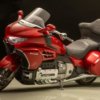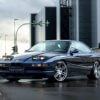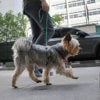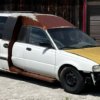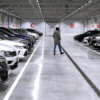
What is this thing? The unusual vehicle was reminiscent of CatDog from the popular animated series, only created from a pair of sedans from the 1950s. The Blue Goose, as it is called, has a rather curious and mysterious fate.
The Blue Goose was built in Plaster City, California by US Gypsum. The city mined and processed gypsum, from which drywall is made. As you would expect from a large mining and manufacturing enterprise, it had its own railroad, and it was through these skies that the Blue Goose would fly.
The narrow gauge line connected the USG Plaster City processing plant to the Fish Mountains quarry, located about 40 kilometers away. In addition to the gypsum itself, the U.S. government had to transport quarry crews to and from the site wearing something that would protect them from the desert heat and sandstorms.
However, since narrow gauge railways were not widely used, there was probably no ready-made transport solution to accomplish this task. Then the US government took matters into its own hands.

At some point in the mid-1950s, the US government took possession of two 1953 Chrysler New Yorker Club coupes. It was decided to use their bodies, rotating one 180 degrees, and extending the space between them to create something like a two-cabin limousine.
The resulting monster was 11.5 meters long, weighed 2,700 kg and had controls at both ends, so it did not need to turn around to change direction.
The Blue Goose could reach a top speed of 65 km/h using a single, centrally located 160-horsepower engine, the origins of which are lost in time. According to one assumption, it could be the then new 5.4-liter Hemi V8.
As for the name “Blue Goose”, it is not known exactly where it came from. It is hypothesized that the name alludes to the similar narrow-gauge Galloping Goose railcars, cheap train replacements that ran between Denver and the Rio Grande Western during the Great Depression.

There is also no record of its service life, although it is believed that the Blue Goose made its last voyage around 1970. By then it was too worn out, but there was another more exciting reason.
“My brother and I have ridden the Blue Goose many times—our father, Don Haskell, was the superintendent of a US gypsum quarry when it was built,” Carol Haskell said in a comment on a US government Facebook post. “It was really very fast and had difficulty staying on the narrow gauge rails, so the company decided that the handcar could be dangerous.”
What happened to him next? Here sources differ in information: either it was cut into scrap metal, or it is still stored somewhere in a private collection. According to one version, the railcar was to be donated in 1970 to the Pacific Southwest Railroad Museum Association. But other sources say that the Blue Goose was destroyed before this could happen.

Subscribe to our Telegram channel

